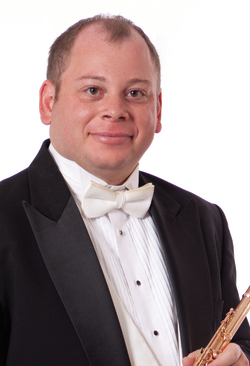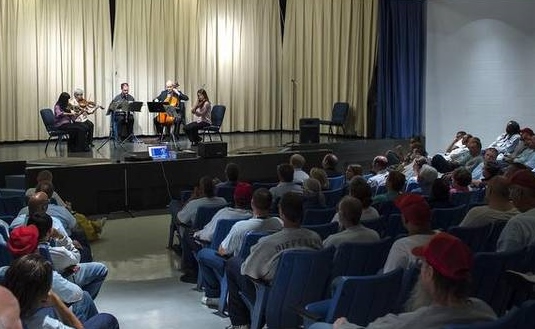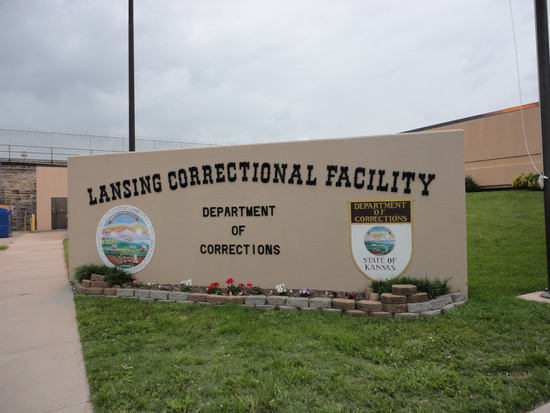
Photo courtesy of Kansas City Symphony
Prison is one place I never imagined myself visiting voluntarily. It is certainly not a place I would have gone to have a deeply meaningful musical experience. Nevertheless, in May 2015, I and five other members of the Kansas City Symphony did just that. What resulted was an incredible affirmation of the power and value of classical music, and a truly unique learning experience that none of us will forget.
This all began one evening in the symphony’s donor lounge when I struck up a friendly conversation with one of our staunchest supporters, Tom Smeed. Tom is a gentleman who freely admits he gave no thought to classical music for most of his life, but decided to check out a concert a few years ago on a whim as an opportunity to have a night out with his daughter. He was instantly captivated, and has been a full season subscriber and donor ever since. It turns out that well before he developed a passion for music, he had a passion for volunteering at prisons.
That evening, Tom told me about his work with a small non-profit in nearby Kansas called Arts in Prison. They create opportunities for inmates at Lansing State Prison to do arts activities ranging from choral singing and rap, to putting on fully staged Shakespeare plays. Tom thought it would be a great idea for musicians to perform for the inmates. The Kansas City Symphony has a program called Community Connections Initiative, which pays musicians to participate in all manner of projects, and I was sure we could get a group together.

KCS Musicians Tamamo Gibbs and Mary Grant (violin), John Klinghammer (clarinet), Alex East (cello), Jessica Nance (viola)
Photo credit: David Eulitt
The day of the concert, we arrived at Lansing Prison and were taken in through the various security checkpoints together. First was an airport style screening. The guards examined our bags and cases thoroughly, and checked our identifications. Then we were escorted down a long corridor and through a heavy steel door into a relatively small chamber with a guard located behind a window. The door closed behind us. The guard examined our I.D.’s once again. Then another heavy steel door was opened and on the other side was the prison yard.
As we walked across the yard, I was immediately surprised to find myself surrounded by people talking amongst their friends, running on the track, relaxing on benches, reading books; it was almost like being on a college campus. Inside the auditorium there were inmates there to help us set up chairs on stage, show us where to store our cases, and set up the microphone. They were friendly, helpful, and very excited about our concert. They had a real pride in the theater, and in making us feel comfortable and welcome. Later in the evening, the warden told us that the men take better care of the auditorium than they would of their own homes.

Photo Courtesy of Kansas City Symphony
Programming for this concert, as often happens, was admittedly dictated more by the constraints of available personnel and rehearsal time than by a concept for the perfect collection of works. We had a string quartet plus flute and clarinet to work with. We settled on three works: Haydn’s London Trio No. 3, Mozart’s Clarinet Quintet, and Ligeti’s Old Hungarian Ballroom Dances for string quartet, flute, and clarinet. As I was preparing my comments, I discovered there was a very appropriate emotional connection between these works and what some of the inmates might be experiencing in their own lives. In the case of the Mozart, the work was written at a very difficult time when he was financially broke from caring for his ill wife, and his music had fallen out of favor. In the case of the Ligeti, this is an example of a work written for the critics in a very imposed style that sounds more like Dvořák and nothing like the avant-garde works with which we are all familiar.
As we performed, there was an incredibly focused quiet in the room, as if we were in any other concert hall. Only once did I notice an inmate start to talk during the Mozart Quintet, and immediately another inmate beside him insisted he be quiet. The prisoners were some of the most engaged and enthusiastic audience members for whom we have ever played. The applause after our first offering, the Haydn Trio, was overwhelming, and instantly relieved any concern over how we would be received.
We finished the program with what turned out to be a rather long Q & A session. The inmates asked so much more than the predictable “how old were you when you started learning music” and “what’s your favorite piece”. They asked questions about life as a symphony musician. They even asked if we could teach them some music. One gentleman simply wanted to know if we would consider another visit. Our promise to return elicited yet another round of boisterous applause and cheers.
The inmates were permitted to come speak to us one on one as we packed up our instruments, and they literally lined up to shake our hands, and have a word. One inmate wanted to send his mother a birthday card with all of our signatures on it. Others simply wanted to share their own stories of how our music was meaningful to them, or how it made their day better.
Following the concert, the warden escorted us on a brief tour of the prison grounds. He spoke at length about the programs at Lansing that are aimed at rehabilitating prisoners. They offer classes in all sorts of academic subjects, all taught by volunteers. They have counseling available which helps inmates reconnect and reconcile with their families on the outside. Inmates have the opportunity to work for pay in the on-site embroidery plant. The goal of all of these programs is to prepare the inmates to return to free society.
What was truly surprising to learn is that Lansing is much more the exception than the rule. In many prisons, inmates are released back into the world with no money, no education, no prospects, estranged from their families, and shunned by free society. It is a state of struggle and desperation that often leads them back to crime. It is clear that Lansing’s approach is working. The recidivism rate there is well below the national average.
Nearly all of the prisoners at Lansing will one day be released. While they are incarcerated, it is easy to forget that these people are still part of our community. It was so impactful for us to see just how genuinely these men appreciated the openness and the dignity we showed them. Most of the men assume free people would prefer to lock them up and throw away the key. The simple act of sharing music made them feel remembered, and hopefully will one day inspire them to be more invested and productive members of peaceful law abiding society. One rarely expects a criminal to be gracious, kind, appreciative, compassionate, or humble, yet each person we met exuded all of these qualities. While their crimes cannot be ignored, it can be all too easy to ignore their humanity.
As promised, we returned just this past January with an entirely different group of musicians and performed another concert for a larger, and even more enthusiastic audience. We plan to go back again this spring. I must extend special thanks to Tom Smeed for envisioning this project, Leigh Lynch from Arts in Prison and the staff of the Kansas City Symphony for their support, and most importantly to my fifteen wonderful colleagues who agreed to go behind bars. I hope this story will inspire other musicians to share music with forgotten members of their communities.
Note:The author is a member of the Kansas City Symphony





